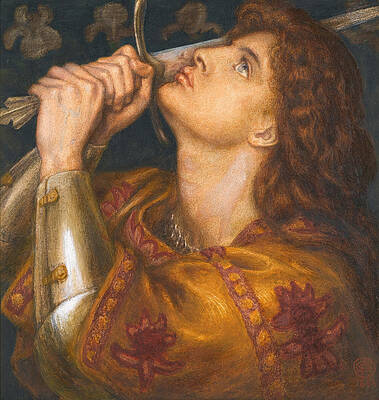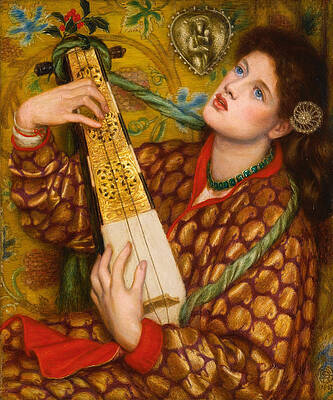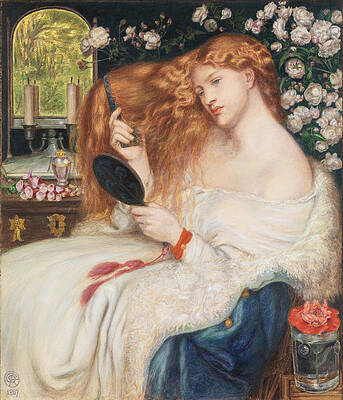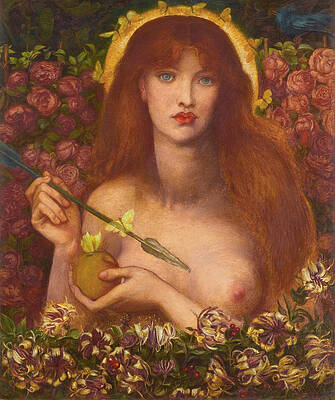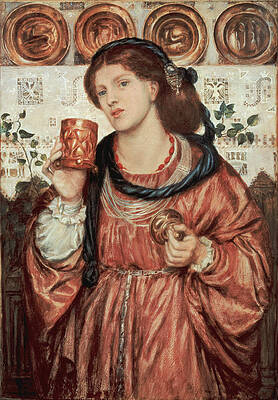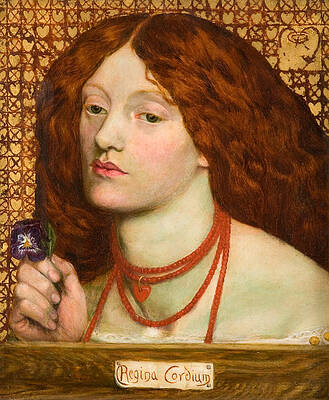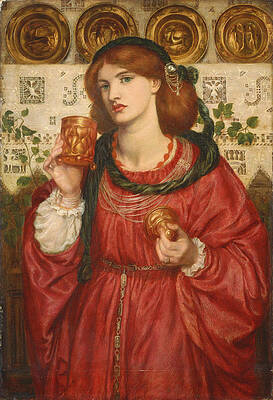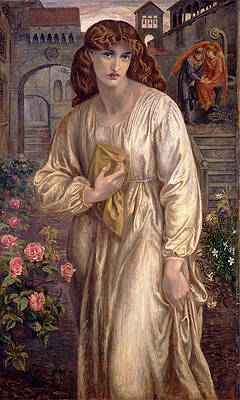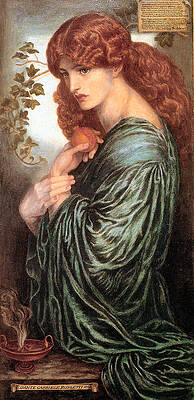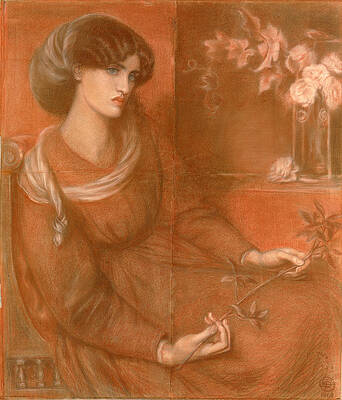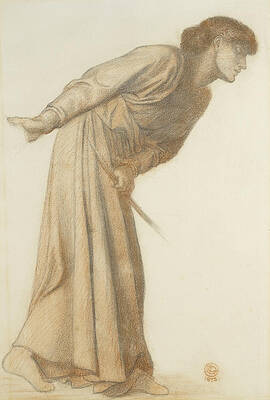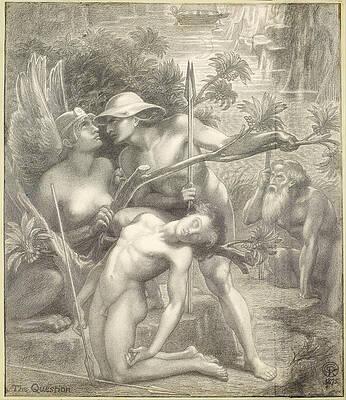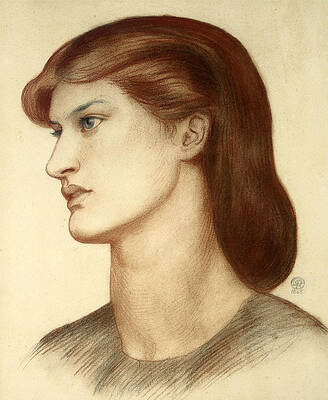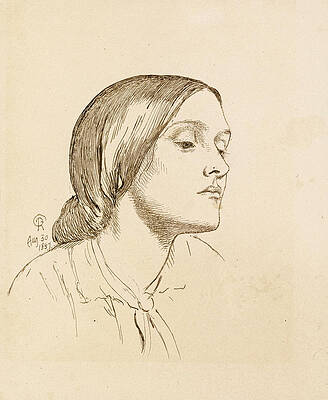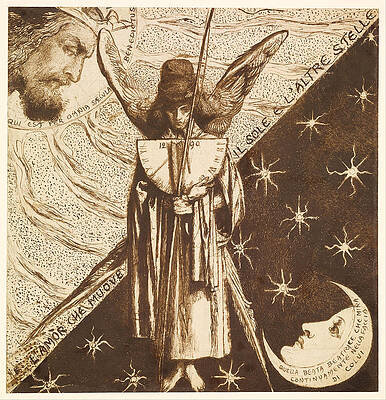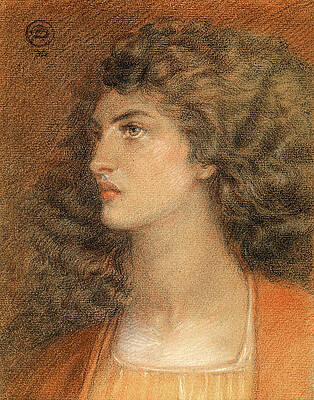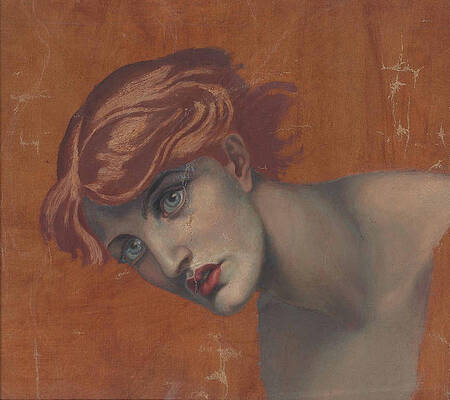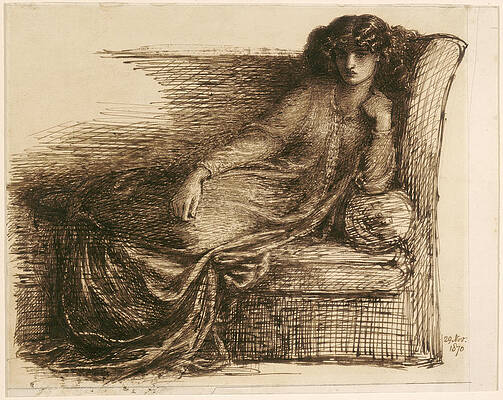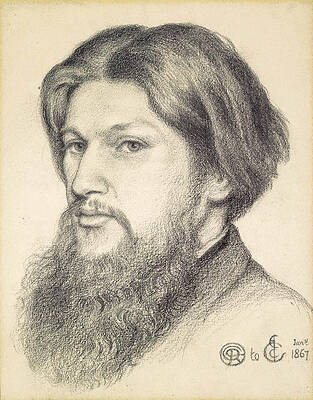Dante Gabriel Rossetti
Joan of Arc
A Christmas Carol
Lady Lilith
Venus Verticordia
The Loving Cup
Regina Cordium. Queen of Hearts
The Loving Cup
The Day Dream
Salutation of Beatrice
Proserpine

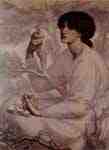
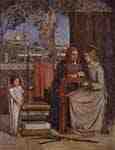
The education of the young Mary
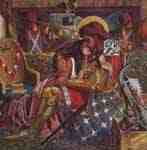
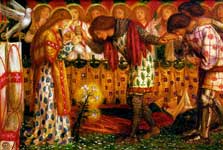
How Sir Galahad, Sir Bors and Sir Percival Were Fed with the Sanc Grael


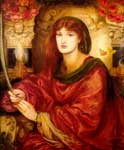
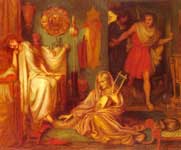
The Return Of Tibullus To Delia
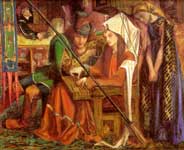

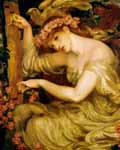



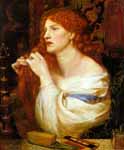
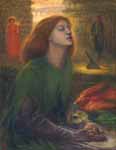
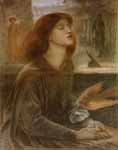

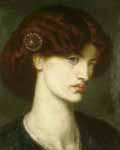

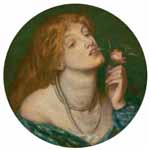
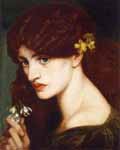

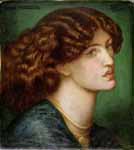
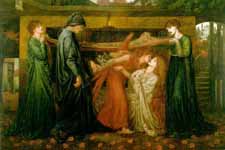
Dante Alighieri series - Dante's Dream at the Time of the Death of Beatrice,
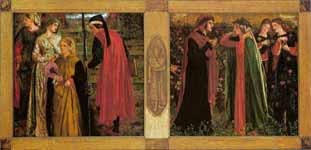
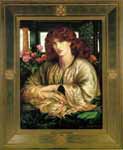

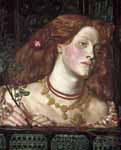
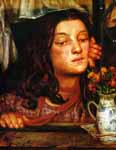

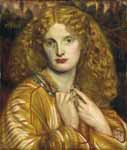
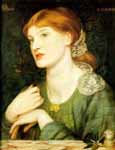
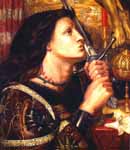
Joan of Arc Kisses the Sword of Liberation
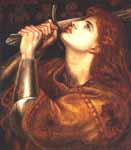


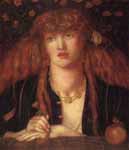
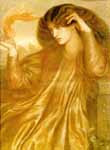
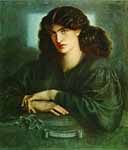

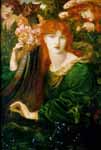
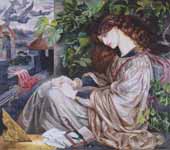
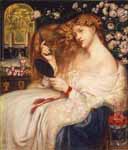
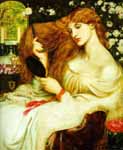

Ligeia Siren

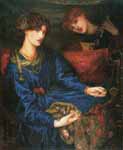
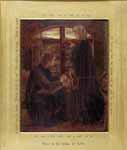
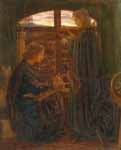
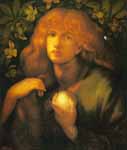
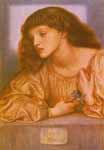
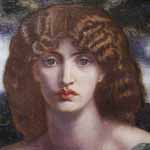
Mnemosyne ( Lamp of Memory and Ricordanza), detail

Mnemosyne ( Lamp of Memory and Ricordanza)
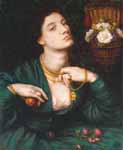
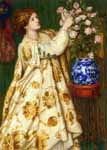

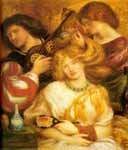
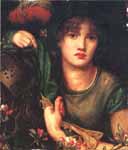



Portrait of Algernon Swinburne
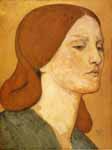

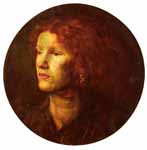
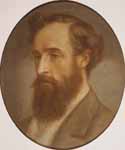
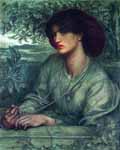
Portrait of Jane Morris (Gold Chain)
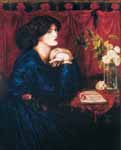
Portrait of Jane Morris (The Blue Silk Dress)
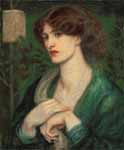
Portrait of Jane Morris as Beatrice
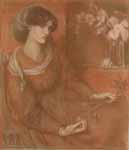
Portrait of Jane Morris, nee Burden
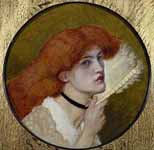
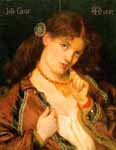
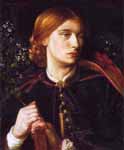
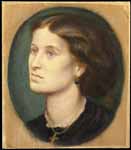
Portrait of Mrs Vernon Lushington

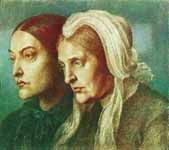
Portrait of the artist's sister Christina and mother Frances




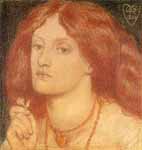
Regina Cordium or The Queen of Hearts
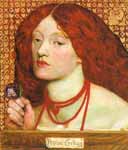
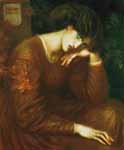

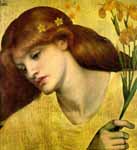
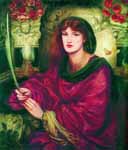


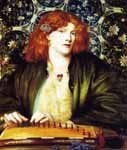
The Bleu Bower (Fanny Conforth)
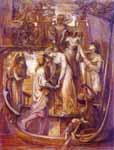

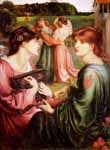
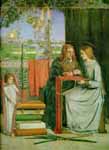

The Damsel of the Sanct Grael or The Holy Grail


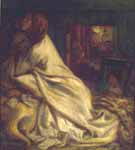
The Heart of the Night (Mariana in the Moated Grange)
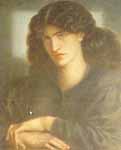
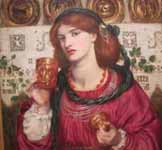
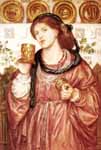
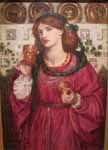
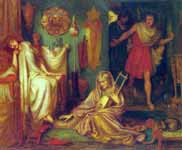
The Return Of Tibullus To Delia
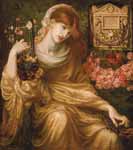
The Roman widow ( Dis Manibus)
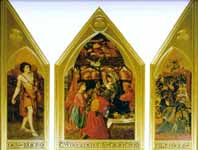

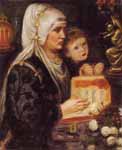
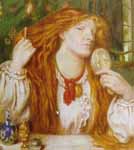
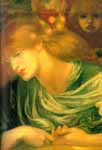
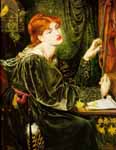
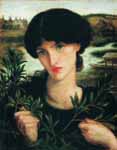
Drawings
Jane Morris. Study for Mariana
Dante's Dream at the Time of the Death of Beatrice, Study for figure of Love
La Mandolinata
The Question. The Sphinx
Paolo and Francesca da Rimini
Sir Galahad at the ruined Chapel
Io sono in pace
Portrait of Alexa Wilding
Portrait of Maria Hungerford Pollen
Regina Cordium, Study of Alexa Wilding
Girl Singing to a Lute
Dantis Amor. Finished Study
Portrait of Miss Herbert
Desdemona's Death-Song
Jane Morris
Portrait of Ford Madox Brown
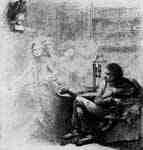 The happiness appears Taurello for the first time
The happiness appears Taurello for the first time
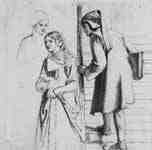

The acquisition of the Holy Grail

Elizabeth Siddal at the Window

Elizabeth Siddal, her hair braiding
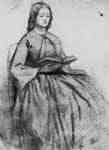
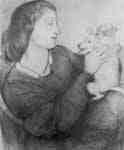
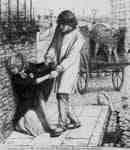
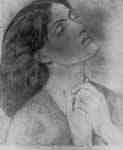
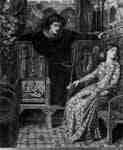
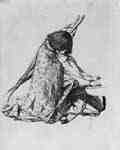
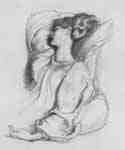
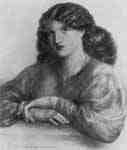
La Donna della Finestra (Jane Morris)
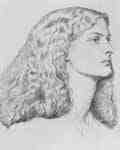

Portrait of Christina Rossetti
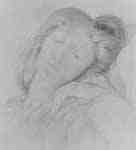
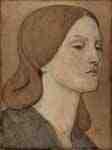


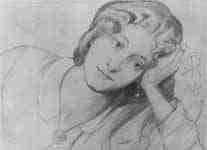
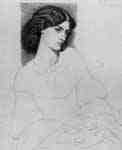
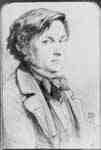
Portrait of the Fox Madox Brown

Portrait of Thomas Woolner, Tondo
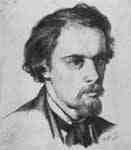
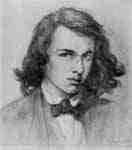


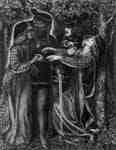
Fine Art Prints | Greeting Cards | Phone Cases | Lifestyle | Face Masks | Men's , Women' Apparel | Home Decor | jigsaw puzzles | Notebooks | Tapestries | ...
Dante Gabriel Rossetti (/ˈdænti ˈɡeɪbriəl rəˈzɛti/;[1] 12 May 1828 – 9 April 1882) was an English poet, illustrator, painter and translator. He founded the Pre-Raphaelite Brotherhood in 1848 with William Holman Hunt and John Everett Millais, and was later to be the main inspiration for a second generation of artists and writers influenced by the movement, most notably William Morris and Edward Burne-Jones. His work also influenced the European Symbolists and was a major precursor of the Aesthetic movement.
Rossetti's art was characterised by its sensuality and its medieval revivalism. His early poetry was influenced by John Keats. His later poetry was characterised by the complex interlinking of thought and feeling, especially in his sonnet sequence The House of Life. Poetry and image are closely entwined in Rossetti's work; he frequently wrote sonnets to accompany his pictures, spanning from The Girlhood of Mary Virgin (1849) and Astarte Syriaca (1877), while also creating art to illustrate poems such as "Goblin Market" by the celebrated poet Christina Rossetti, his sister.
Rossetti's personal life was closely linked to his work, especially his relationships with his models and muses Elizabeth Siddal, Fanny Cornforth and Jane Morris.Early life
Self-portrait, 1847
The son of émigré Italian scholar Gabriele Pasquale Giuseppe Rossetti and his wife Frances Polidori, Rossetti was born in London, and named Gabriel Charles Dante Rossetti. His family and friends called him Gabriel, but in publications he put the name Dante first (in honour of Dante Alighieri). He was the brother of poet Christina Rossetti, critic William Michael Rossetti, and author Maria Francesca Rossetti.[2] During his childhood, Rossetti was home educated and often read the Bible, along with the works of Shakespeare, Dickens, Sir Walter Scott and Lord Byron.[3]
The young Rossetti is described as "self-possessed, articulate, passionate and charismatic"[4] but also "ardent, poetic and feckless".[5] Like all his siblings, he aspired to be a poet and attended King's College School, in its original location near the Strand. He also wished to be a painter, having shown a great interest in Medieval Italian art. He studied at Henry Sass's Drawing Academy from 1841 to 1845 when he enrolled at the Antique School of the Royal Academy, leaving in 1848. After leaving the Royal Academy, Rossetti studied under Ford Madox Brown, with whom he retained a close relationship throughout his life.[2]
Following the exhibition of William Holman Hunt's painting The Eve of St. Agnes, Rossetti sought out Hunt's friendship. The painting illustrated a poem by the little-known John Keats. Rossetti's own poem, "The Blessed Damozel", was an imitation of Keats, and he believed Hunt might share his artistic and literary ideals. Together they developed the philosophy of the Pre-Raphaelite Brotherhood which they founded along with John Everett Millais.
Portrait of Dante Gabriel Rossetti at 22 years of Age by William Holman Hunt
The group's intention was to reform English art by rejecting what they considered to be the mechanistic approach first adopted by the Mannerist artists who succeeded Raphael and Michelangelo and the formal training regime introduced by Sir Joshua Reynolds. Their approach was to return to the abundant detail, intense colours, and complex compositions of Quattrocento Italian and Flemish art.[6][7] The eminent critic John Ruskin wrote:
Every Pre-Raphaelite landscape background is painted to the last touch, in the open air, from the thing itself. Every Pre-Raphaelite figure, however studied in expression, is a true portrait of some living person.[8]
For the first issue of the brotherhood's magazine, The Germ, published early in 1850, Rossetti contributed a poem, "The Blessed Damozel", and a story about a fictional early Italian artist inspired by a vision of a woman who bids him combine the human and the divine in his art.[9] Rossetti was always more interested in the medieval than in the modern side of the movement, working on translations of Dante and other medieval Italian poets, and adopting the stylistic characteristics of the early Italians.
Career
Beginnings
The Girlhood of Mary Virgin (1849). (Models: the artist's mother for St. Anne and his sister Christina for the Virgin).[10]
Rossetti's first major paintings in oil display the realist qualities of the early Pre-Raphaelite movement. His Girlhood of Mary Virgin (1849) and Ecce Ancilla Domini (1850) portray Mary as a teenage girl. William Bell Scott saw Girlhood in progress in Hunt's studio and remarked on young Rossetti's technique:
He was painting in oils with water-colour brushes, as thinly as in water-colour, on canvas which he had primed with white till the surface was a smooth as cardboard, and every tint remained transparent. I saw at once that he was not an orthodox boy, but acting purely from the aesthetic motive. The mixture of genius and dilettantism of both men shut me up for the moment, and whetted my curiosity.[11]
Stung by criticism of his second major painting, Ecce Ancilla Domini, exhibited in 1850, and the "increasingly hysterical critical reaction that greeted Pre-Raphaelitism"[6] that year, Rossetti turned to watercolours, which could be sold privately. Although his work subsequently won support from John Ruskin, Rossetti only rarely exhibited thereafter.[6]
Dante and Medievalism
In 1850, Rossetti met Elizabeth Siddal, an important model for the Pre-Raphaelite painters. Over the next decade, she became his muse, his pupil, and his passion. They were married in 1860.[12]
Original manuscript of "Autumn Song" by Rossetti, 1848, in the Ashley Library
Rossetti's incomplete picture Found, begun in 1853 and unfinished at his death, was his only major modern-life subject. It depicted a prostitute, lifted from the street by a country drover who recognises his old sweetheart. However, Rossetti increasingly preferred symbolic and mythological images to realistic ones,[4]
For many years, Rossetti worked on English translations of Italian poetry including Dante Alighieri's La Vita Nuova (published as The Early Italian Poets in 1861). These and Sir Thomas Malory's Le Morte d'Arthur inspired his art of the 1850s. He created a method of painting in watercolours, using thick pigments mixed with gum to give rich effects similar to medieval illuminations. He also developed a novel drawing technique in pen-and-ink. His first published illustration was "The Maids of Elfen-Mere" (1855), for a poem by his friend William Allingham, and he contributed two illustrations to Edward Moxon's 1857 edition of Alfred, Lord Tennyson's Poems and illustrations for works by his sister Christina Rossetti.[13]
The Day Dream. The sitter is Jane Morris.[14][15][16]
His visions of Arthurian romance and medieval design also inspired William Morris and Edward Burne-Jones.[17] Neither Burne-Jones nor Morris knew Rossetti, but were much influenced by his works, and met him by recruiting him as a contributor to their Oxford and Cambridge Magazine which Morris founded in 1856 to promote his ideas about art and poetry.[18][19]
In February 1857, Rossetti wrote to William Bell Scott:
Two young men, projectors of the Oxford and Cambridge Magazine, have recently come up to town from Oxford, and are now very intimate friends of mine. Their names are Morris and Jones. They have turned artists instead of taking up any other career to which the university generally leads, and both are men of real genius. Jones's designs are marvels of finish and imaginative detail, unequalled by anything unless perhaps Albert Dürer's finest works.[18]
That summer Morris and Rossetti visited Oxford and finding the Oxford Union debating-hall under construction, pursued a commission to paint the upper walls with scenes from Le Morte d'Arthur and to decorate the roof between the open timbers. Seven artists were recruited, among them Valentine Prinsep and Arthur Hughes,[20] and the work was hastily begun. The frescoes, done too soon and too fast, began to fade at once and now are barely decipherable. Rossetti recruited two sisters, Bessie and Jane Burden, as models for the Oxford Union murals, and Jane became Morris's wife in 1859.[21]
Religious influence on works
England began to see a revival of religious beliefs and practices starting in 1833 and moving onward to about 1845.[22] The Oxford Movement, also known as the Tractarian Movement, had recently begun a push toward the restoration of Christian traditions that had been lost in the Church.[23] Rossetti and his family had been attending Christ Church on Albany Street, since 1843. His brother, William Michael Rossetti recorded that services began changing in the church since the start of the "High Anglican movement". Rev. William Dodsworth was responsible for these changes, including the addition of the Catholic practice of placing flowers and candles by the altar. Rossetti and his family, along with two of his colleagues (one of which cofounded the Pre-Raphaelite Brotherhood) had also attended St. Andrew's on Wells Street, a High Anglican church. It is noted that the Anglo-Catholic revival very much affected Rossetti in the late 1840s and early 1850s. The spiritual expressions of his painting The Girlhood of Mary Virgin, finished in 1849, are evident of this claim. The painting's altar is decorated very similarly to that of a Catholic altar, proving his familiarity with the Anglo-Catholic revival. The subject of the painting, the Blessed Virgin, is sewing a red cloth, a significant part of the Oxford Movement that emphasized the embroidering of altar cloths by women.[24] Oxford Reformers identified two major aspects to their movement, that "the end of all religion must be communion with God," and "that the Church was divinely instituted for the very purpose of bringing about this consummation."[25]
From the beginning of the Pre-Raphaelite Brotherhood's formation in 1848, their pieces of art included subjects of noble or religious disposition. Their aim was to communicate a message of "moral reform" through the style of their works, exhibiting a "truth to nature".[26] Specifically in Rossetti's "Hand and Soul," written in 1849, he displays his main character Chiaro as an artist with spiritual inclinations. In the text, Chiaro's spirit appears before him in the form of a woman who instructs him to "set thine hand and thy soul to serve man with God."[27] The Rossetti Archive defines this text as "Rossetti's way of constellating his commitments to art, religious devotion, and a thoroughly secular historicism."[28] Likewise, in "The Blessed Damozel," written between 1847 and 1870, Rossetti uses biblical language such as "From the gold bar of Heaven" to describe the Damozel looking down to Earth from Heaven.[29] Here we see a connection between body and soul, mortal and supernatural, a common theme in Rossetti's works. In "Ave" (1847), Mary awaits the day that she will meet her son in Heaven, uniting the earthly with the heavenly. The text highlights a strong element in Anglican Marian theology that describes Mary's body and soul having been assumed into Heaven.[24]
A new direction
Bocca Baciata (1859) signalled a new direction on Rossetti's work. (Model: Fanny Cornforth)
Around 1860, Rossetti returned to oil painting, abandoning the dense medieval compositions of the 1850s in favour of powerful close-up images of women in flat pictorial spaces characterised by dense colour. These paintings became a major influence on the development of the European Symbolist movement.[30] In them, Rossetti's depiction of women became almost obsessively stylised. He portrayed his new lover Fanny Cornforth as the epitome of physical eroticism, whilst Jane Burden, the wife of his business partner William Morris, was glamorised as an ethereal goddess. "As in Rossetti's previous reforms, the new kind of subject appeared in the context of a wholesale reconfiguration of the practice of painting, from the most basic level of materials and techniques up to the most abstract or conceptual level of the meanings and ideas that can be embodied in visual form."[30] These new works were based not on medievalism, but on the Italian High Renaissance artists of Venice, Titian and Veronese.[30][31]
In 1861, Rossetti became a founding partner in the decorative arts firm, Morris, Marshall, Faulkner & Co. with Morris, Burne-Jones, Ford Madox Brown, Philip Webb, Charles Faulkner and Peter Paul Marshall.[19] Rossetti contributed designs for stained glass and other decorative objects.
Rossetti's wife Elizabeth Siddal died of an overdose of laudanum in 1862, shortly after giving birth to a stillborn child. Rossetti became increasingly depressed, and on the death of his beloved Lizzie, buried the bulk of his unpublished poems with her at Highgate Cemetery, though he later had them dug up. He idealised her image as Dante's Beatrice in a number of paintings, such as Beata Beatrix.[32]
Cheyne Walk years
His home at 16 Cheyne Walk, London
After the death of his wife, Rossetti leased Tudor House at 16, Cheyne Walk, in Chelsea, where he lived for 20 years surrounded by extravagant furnishings and a parade of exotic birds and animals.[33] Rossetti was fascinated with wombats, asking friends to meet him at the "Wombat's Lair" at the London Zoo in Regent's Park, and spending hours there. In September 1869 he acquired the first of two pet wombats, which he named "Top". It was brought to the dinner table and allowed to sleep in the large centrepiece during meals. Rossetti's fascination with exotic animals continued throughout his life, culminating in the purchase of a llama and a toucan, which he dressed in a cowboy hat and was trained to ride the llama round the dining-table for his amusement.[34]
Rossetti maintained Fanny Cornforth (described delicately by William Allington as Rossetti's "housekeeper")[35] in her own establishment nearby in Chelsea, and painted many voluptuous images of her between 1863 and 1865.[36]
Rossetti's The Roman Widow at Museo de Arte de Ponce, Puerto Rico
In 1865 he discovered auburn-haired Alexa Wilding, a dressmaker and would-be actress who was engaged to model for him on a full-time basis and sat for The Blessed Damozel and other paintings.[37] She sat for more of his finished works than any other model, but comparatively little is known about her due to the lack of any romantic connection with Rossetti. He spotted her one evening in the Strand in 1865 and was immediately struck by her beauty. She agreed to sit for him the following day, but failed to arrive. He spotted her again weeks later, jumped from the cab he was in and persuaded her to go straight to his studio. He paid her a weekly fee to sit for him exclusively, afraid that other artists might employ her.[38] They shared a lasting bond; after Rossetti's death Wilding was said to have travelled regularly to place a wreath on his grave.[39]
Jane Morris, whom Rossetti had used as a model for the Oxford Union murals he painted with William Morris and Edward Burne-Jones in 1857, also sat for him during these years, she "consumed and obsessed him in paint, poetry, and life".[37] In 1869, Morris and Rossetti rented a country house, Kelmscott Manor at Kelmscott, Oxfordshire, as a summer home, but it became a retreat for Rossetti and Jane Morris to have a long-lasting and complicated liaison. They spent summers there with the Morris's children, while Morris travelled to Iceland in 1871 and 1873.[40]
Rossetti reading proofs of Ballads and Sonnets at 16 Cheyne Walk, by Henry Treffry Dunn (1882)
During these years, Rossetti was prevailed upon by friends, in particular Charles Augustus Howell, to exhume his poems from his wife's grave which he did, collating and publishing them in 1870 in the volume Poems by D. G. Rossetti. They created controversy when they were attacked as the epitome of the "fleshly school of poetry". Their eroticism and sensuality caused offence. One poem, "Nuptial Sleep", described a couple falling asleep after sex. It was part of Rossetti's sonnet sequence The House of Life, a complex series of poems tracing the physical and spiritual development of an intimate relationship. Rossetti described the sonnet form as a "moment's monument", implying that it sought to contain the feelings of a fleeting moment, and reflect on their meaning. The House of Life was a series of interacting monuments to these moments – an elaborate whole made from a mosaic of intensely described fragments. It was Rossetti's most substantial literary achievement. The collection included some translations, including his "Ballad Of Dead Ladies", an 1869 translation of François Villon's poem "Ballade des dames du temps jadis. (The word "yesteryear" is credited to Rossetti as a neologism used for the first time in this translation.)
In 1881, Rossetti published a second volume of poems, Ballads and Sonnets, which included the remaining sonnets from The House of Life sequence.
Decline and death
Alexa Wilding (1879)
The savage reaction of critics to Rossetti's first collection of poetry contributed to a mental breakdown in June 1872, and although he joined Jane Morris at Kelmscott that September, he "spent his days in a haze of chloral and whisky".[41] The next summer he was much improved, and both Alexa Wilding and Jane sat for him at Kelmscott, where he created a soulful series of dream-like portraits.[41] In 1874, Morris reorganised his decorative arts firm, cutting Rossetti out of the business, and the polite fiction that both men were in residence with Jane at Kelmscott could not be maintained. Rossetti abruptly left Kelmscott in July 1874 and never returned. Toward the end of his life, he sank into a morbid state, darkened by his drug addiction to chloral hydrate and increasing mental instability. He spent his last years as a recluse at Cheyne Walk.
On Easter Sunday, 1882, he died at the country house of a friend, where he had gone in a vain attempt to recover his health, which had been destroyed by chloral as his wife's had been destroyed by laudanum. He died of Bright's Disease, a disease of the kidneys from which he had been suffering for some time. He had been housebound for some years on account of paralysis of the legs, though his chloral addiction is believed to have been a means of alleviating pain from a botched hydrocele removal. He had been suffering from alcohol psychosis for some time brought on by the excessive amounts of whisky he used to drown out the bitter taste of the chloral hydrate. He is buried at Birchington-on-Sea, Kent, England. His grave is visited by admirers of his life's work and achievements as seen by fresh flowers placed there regularly.
Collections and critical assessment
Albumen print of Dante Gabriel Rossetti by Charles Lutwidge Dodgson (Lewis Carroll) (1863)
Tate Britain, Birmingham, Manchester and Salford Museum and Art Galleries all contain large collections of Rossetti's work; the latter was bequeathed a number of works following the death of L. S. Lowry in 1976. Lowry was president of the Newcastle-based 'Rossetti Society', which was founded in 1966.[42] Lowry's private collection of works was chiefly built around Rossetti's paintings and sketches of Lizzie Siddal and Jane Morris, and notable pieces included Pandora, Proserpine and a drawing of Annie Miller.
In an interview with Mervyn Levy, Lowry explained his fascination with the Rossetti women in relation to his own work: "I don't like his women at all, but they fascinate me, like a snake. That's why I always buy Rossetti whenever I can. His women are really rather horrible. It's like a friend of mine who says he hates my work, although it fascinates him."[43] The friend Lowry referred to was businessman Monty Bloom, to whom he also explained his obsession with Rossetti's portraits: "They are not real women.[...] They are dreams.[...] He used them for something in his mind caused by the death of his wife. I may be quite wrong there, but significantly they all came after the death of his wife."[43]
Blue plaque at 16 Cheyne Walk
The popularity, frequent reproduction, and general availability of Rossetti's later paintings of women have led to this association with "a morbid and languorous sensuality".[44] His small-scale early works and drawings are less well known, but it is in these that his originality, technical inventiveness, and significance in the movement away from Academic tradition can best be seen.[45] As Roger Fry wrote in 1916, "Rossetti more than any other artist since Blake may be hailed as a forerunner of the new ideas" in English Art.[46]
Media
Film
Rossetti was played by Oliver Reed in Ken Russell's television film Dante's Inferno (1967). The Pre-Raphaelite Brotherhood has been the subject of two BBC period dramas. The first, The Love School, (1975) features Ben Kingsley as Rossetti. The second was Desperate Romantics, in which Rossetti is played by Aidan Turner. It was broadcast on BBC Two on Tuesday, 21 July 2009.[47]
Influence
Rossetti's poem "The Blessed Damozel" was the inspiration for Claude Debussy's cantata "La damoiselle élue" (1888).
John Ireland (1879–1962) set to music as one of his Three Songs (1926), Rossetti's poem "The One Hope" from Poems (1870).
In 1904 Ralph Vaughan Williams (1872-1958) created his song cycle The House of Life from six poems by Rossetti. One song in that cycle, Silent Noon, is one of William's best known and most frequently performed songs.
Selected works
Books
The Early Italian Poets (a translation) (1861) republished as Dante and His Circle (1874)
Poems (1870) revised and reissued as Poems. A New Edition (1881)
Ballads and Sonnets (1881)
The Collected Works of Dante Gabriel Rossetti (posthumous, 2 volumes, 1886)
Ballads and Narrative Poems (posthumous, 1893)
Sonnets and Lyrical Poems (posthumous, 1894)
The Works of Dante Gabriel Rossetti (posthumous, 1911) (1911)[48]
Double works
"Rossetti divided his attention between painting and poetry for the rest of his life" - Poetry Foundation[3]
Aspecta Medusa (1865 October 1865 – 1868)
Astarte Syriaca (for a Picture) (1877 January-1877 February 1875 – 1877)
Beatrice, her Damozels, and Love (1865?)
Beauty and the Bird (1855; 1858 June 25)
The Blessed Damozel (1847-1870; 1871-1881)
Bocca Baciata (1859-1860)
Body's Beauty (1864-1869; 1866)
The Bride's Prelude [1848 1870 (circa)]
Cassandra (For a Drawing.) (1869 September; 1860-1861, 1867, 1869)
Dante's Dream on the Day of the Death of Beatrice: 9 June 1290 (1875? 1856)
Dante Alighieri. “Sestina. Of the Lady Pietra degli Scrovigni.” (1848? 1861, 1874)
Dante at Verona [1848-1850 1852 (circa)]
The Day-Dream (for a Picture) (1878-1880; 1880 September)
Death of A Wombat (1869 November 6)
Eden Bower [1863-1864 (circa) or 1869 (circa)]
Fazio's Mistress (1863; 1873)
Fiammetta (For a Picture) [1878 (circa) 1878]
“Found” (for a Picture) (1854; 1881 February)
Francesca Da Rimini. (Dante.) (1855; 1862 September)
Guido Cavalcanti. “Ballata. He reveals, in a Dialogue, his increasing love for Mandetta.” (1861)
Hand and Soul (1849)
Hero's Lamp (1875)
Introductory Sonnet ("A Sonnet is a moment's monument") (1880)
Joan of Arc [1879 (unfinished) 1863, 1882]
La Bella Mano (For a Picture) (1875)
La Pia. Dante (1868-1880)
Lisa ed Elviro (1843)
Love's Greeting (1850, 1861, 1864)
Mary's Girlhood (For a Picture) [1848 (sonnet I), 1849 (sonnet II) 1848-1849]
Mary Magdalene at the Door of Simon the Pharisee (For a Drawing) (1853-1859; 1869)
Michael Scott's Wooing (For a Drawing) (1853, 1869-1871, 1875-1876)
Mnemosyne (1880)
Old and New Art (group of 3 poems) [1849 (text); 1857 (picture, circa)]
On William Morris (1871 September)
Pandora (For a Picture) (1869; 1868-1871)
Parody on “Uncle Ned” (1852)
Parted Love! [1869 September-1869 November (circa]
The Passover in the Holy Family (For a Drawing) (1849-1856; 1869 September)
Perlascura. Twelve Coins for One Queen (1878)
The Portrait (1869)
Proserpine (1872; 1871-1882)
The Question (for a Design) (1875; 1882)
“Retro me, Sathana!” (1847, 1848)
The Return of Tibullus to Delia (1853-1855, 1867)
A Sea-Spell (for a Picture) (1870, 1877)
The Seed of David (For a Picture) (1864)
Silence. For a Design (1870, 1877)
Sister Helen [1851-1852; 1870 (circa)]
Sorrentino (1843)
Soul's Beauty (1866; 1864-1870)
St. Agnes of Intercession (1850; 1860)
Troy Town (1863-1864; 1869-1870)
Venus Verticordia. (For a Picture.) (1868 January 16; 1863-1869)
William and Marie. A Ballad (1841) [49]
References
"Dante Gabriel Rossetti - Definition, pictures, pronunciation and usage notes - Oxford Advanced Learner's Dictionary at OxfordLearnersDictionaries.com". oxfordlearnersdictionaries.com.
Treuherz et al. (2003), pp. 15–18.
"Dante Gabriel Rossetti". Poetry Foundation. Retrieved 15 June 2014.
Treuherz et al. (2003), p. 19. Cite error: Invalid <ref> tag; name "Treuherz19" defined multiple times with different content (see the help page).
Hilton (1970), p. 26.
Treuherz et al. (2003), p. 22.
Hilton (1970), pp. 31–35.
Quoted in Marsh (1996), p. 21.
Marsh (1996), p. 21.
Marsh (1996), p. 16.
Marsh (1996), p. 17.
Treuherz et al. (2003), p. 33.
Treuherz et al. (2003), pp. 175–76.
"The Day Dream". www.artmagick.com. Retrieved 2014.
"The Truth of Imagination". tumblr.com.
"Dante Gabriel Rossetti, 'The Day Dream'". /www.vam.ac.uk. Retrieved 2014.
Treuherz et al. (2003), pp. 39–41.
Sidney Lee, ed. (1901). "Burne-Jones, Edward Coley". Dictionary of National Biography, 1901 supplement 3. London: Smith, Elder & Co.
Sidney Lee, ed. (1901). "Morris, William (1834-1896)". Dictionary of National Biography, 1901 supplement 3. London: Smith, Elder & Co.
Watkinson, Ray, "Painting" in Parry (1996), p. 93.
Parry, William Morris, pp. 14-16.
Barry, William. "The Oxford Movement (1833-1845)". New Advent. Robert Appleton Company. Retrieved 15 June 2014.
Tractarian
Bentley, D.M.R. (1977). Rossetti's "Ave" and Related Pictures (Vol. 15 ed.). West Virginia University Press. pp. 21–35.
Taylor, G.W. "John Wesley and the Anglo-Catholic Revival". Project Canterbury. SPCK. Retrieved 15 June 2014.
Meagher, Jennifer. "The Pre-Raphelites". The Metropolitan Museum of Art. Retrieved 15 June 2014.
"Hand and Soul". Victorian Short Fiction Project. Retrieved 6 June 2014.
"Hand and Soul". The Rossetti Archive. Retrieved 15 June 2014.
"The Blessed Damozel". Rossetti Archive. Retrieved 15 June 2014.
Treuherz et al. (2003), pp. 52–54.
Treuherz et al. (2003), p. 64.
Treuherz et al. (2003), p. 80.
Todd (2001), p. 107.
National Library of Australia.
Todd (2001), p. 109.
Todd (2001), p. 113.
Todd (2001), p. 116.
Dunn, Recollections of Dante Gabriel Rossetti and his circle, ed. Mander, (1984) p. 46.
Spencer-Longhurst, The Blue Bower: Rossetti in the 1860s (2006).
Todd (2001), pp. 123–130.
Todd (2001), pp. 128–129.
Rohde (2000). p. 396.
Rohde (2000), p. 276.
Treuherz et al. (2003), p. 12.
Treuherz et al. (2003), p. 16.
Quoted in Treuherz et al. (2003), p. 12.
"BBC Desperate Romantics". BBC News.
"Rossetti Archive Books". Retrieved 15 June 2014.
"Rossetti Archive Doubleworks". The Rossetti Archive. Retrieved 15 June 2014.
"Lady Lilith, Dante Gabriel Rossetti, 1868". Retrieved 21 August 2010.
Bibliography
Ash, Russell (1995), Dante Gabriel Rossetti. London: Pavilion Books ISBN 978-1-85793-412-0; New York: Abrams ISBN 978-1-85793-950-7.
Doughty, Oswald (1949), A Victorian Romantic: Dante Gabriel Rossetti. London: Frederick Muller.
Drew, Rodger (2006), The Stream's Secret: The Symbolism of Dante Gabriel Rossetti. Cambridge: The Lutterworth Press, ISBN 978-0-7188-3057-1.
Fredeman, William E. (1971). Prelude to the Last Decade: Dante Gabriel Rossetti in the summer of 1872. Manchester [Eng.]: The John Rylands Library.
Fredeman, William E. (ed.) (2002–8), The Correspondence of Dante Gabriel Rossetti. 7 vols. Cambridge: Brewer.
Hilto, Timoth (1970). The Pre-Raphelites. London: Thames and Hudson, New York: Abrams.
Lucas, F. L. (2013), Dante Gabriel Rossetti - an anthology (poems and translations, with introduction). Cambridge University Press ISBN 9781107639799 [1]
Marsh, Jan (1996). The Pre-Raphaelites: Their Lives in Letters and Diaries. London: Collins & Brown.
McGann, J. J. (2000). Dante Gabriel Rossetti and the Game that Must Be Lost. New Haven: Yale University Press.
Parry, Linda (1996), ed., William Morris. New York: Abrams, ISBN 0-8109-4282-8.
Roe, Dinah: The Rossettis in Wonderland. A Victorian Family History. London: Haus Publishing, 2011. ISBN 978-1-907822-01-8.
Rossetti, D. G. The House Of Life
Rossetti, D. G., & J. Marsh (2000). Collected Writings of Dante Gabriel Rossetti. Chicago: New Amsterdam Books.
Rossetti, D. G., & W. W. Rossetti, ed. (1911), The Works of Dante Gabriel Rossetti. Ellis, London. (full text)
Sharp, Frank C., and Jan Marsh (2012), The Collected Letters of Jane Morris, Boydell & Brewer, London.
Simons, J. (2008). Rossetti's Wombat: Pre-Raphaelites and Australian animals in Victorian London. London: Middlesex University Press.
Treuherz, Julian, Prettejohn, Elizabeth, and Becker, Edwin (2003). Dante Gabriel Rossetti. London: Thames & Hudson, ISBN 0-500-09316-4.
Todd, Pamela (2001). Pre-Raphaelites at Home, New York: Watson-Giptill Publications, ISBN 0-8230-4285-5.
----
Fine Art Prints | Greeting Cards | Phone Cases | Lifestyle | Face Masks | Men's , Women' Apparel | Home Decor ...
----
Artist
A - B - C - D - E - F - G - H - I - J - K - L - M -
N - O - P - Q - R - S - T - U - V - W - X - Y - Z
Retrieved from "http://en.wikipedia.org/"
All text is available under the terms of the GNU Free Documentation License


